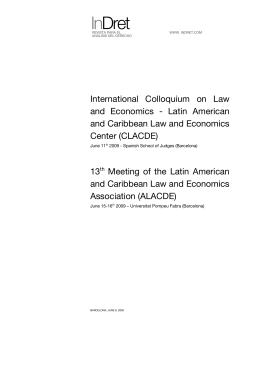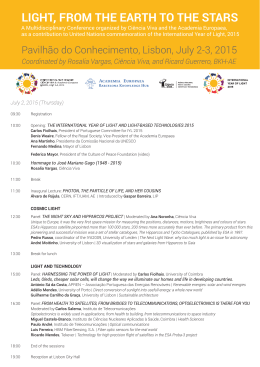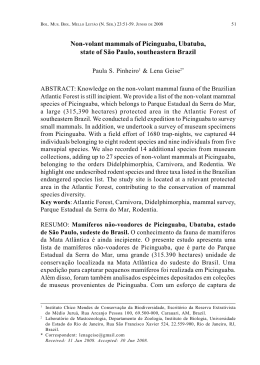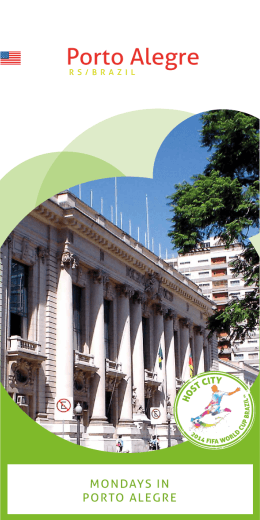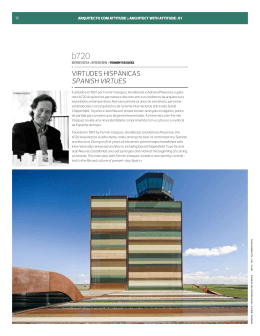Rebuilding urban morphology: new centralities and urban inequalities in Southern European cities Patrícia Pereira Jordi Nofre Keywords: urban inequalities, spatial displacements, “sanitized” city, Lisbon, Barcelona Abstract In most European cities, public administration has been concerned with social, economical, cultural and political integration of marginal urban areas. One of the main strategies to achieve this purpose has been to consider culture as one of the main engines of great urban transformations. In order to gain competitiveness, recent cultural strategies for urban renewal have been mostly led by the building of new urban entertainment and economic clusters in both suburban and marginal areas, a revaluation of cities cultural heritage and the neoliberal branding of their urban space. However, if such centralization of these areas in metropolitan context involves radical urban transformations, it also involves the emergence new urban inequalities. Based on an ongoing-research and focusing in recently renewed neighbourhoods of both metropolitan areas of Lisbon and Barcelona, this paper is focused on processes of social and productive transformations of marginal urban areas. We will also focus on how the neoliberal urbanism favours the achievement of the social and cultural “sanitized” city, based on “spatial displacements” of working classes that are replaced by local and global new middle classes. As conclusion this paper will contribute to the debate about the relations between urban competitiveness and rapid social change in the context of globalisation and its consequences on the everyday segmented Southern European cities. Centro de Estudos de Sociologia da Universidade Nova de Lisboa [email protected] Centro de Estudos de Sociologia da Universidade Nova de Lisboa [email protected] 655 SOCIOLOGIA ON LINE, Nº 2, ABRIL 2011 Introduction The role of cultural policies and of the leisure industry in great urban transformations is reflected in most publications and workshops carried out by public universities and Western administrations. For instance, Eurocities Comitée published a document in 2001 that states that culture is the main “engine” for urban transformations of 21 st century European cities. Undoubtedly, the new role of culture, leisure and associated industries in urban transformation processes has led to the emergence of architecture as a new cultural sector. The postmodern architect-designer, turning away from the principles of universal modern architecture, tends to consider space as independent and autonomous, holding both aesthetic principles and objectives quite far away from any social intention (Harvey, 1990). Urban and suburban spaces are provided with new cultural significances, but any symbol and urban heritage which could remember any local episode of social disorder or dissidence played by anarchists or working-class leaders is removed in order to do not disturb the established political and social order (Goss, 1999; Capel, 2005). Heritage from each city’s “golden” period is emphasized, while other historical periods are overlooked (Griswold, 2009). In this context urban inequalities do not disappear and in many cases they are reinforced. Furthermore, new types of urban governance based on the ecology of fear (Davis, 1992), the re-bordering of the topographies of urban power, the impoverishment of the middle classes, the increasing impoverishment of traditional working classes and the resignation of the traditional bourgeoisie to lead the future of the city are ineludible aspects of the everyday contexts in post-fordist cities. Gentrification and urban reconstruction processes should be added to these facts. Neil Smith (2002) suggests that gentrification may be considered as a one of the most important signs of neoliberal urbanism developed by public administrations since the adoption of business and financial management strategies to the urban governance. Post-fordist cities may be defined as entrepeneurship cities (López, 1991) in which the ruling classes strongly commit themselves to urban reconstruction as one of the main 656 PATRÍCIA PEREIRA E JORDI NOFRE – REBUILDING URBAN MORPHOLOGY: NEW CENTRALITIES AND … strategies to socially and economically (re)develop degraded areas (Infusino, 2010). In fact haussmanian-type urban reconstruction was the elected strategy to (socially) redevelop a great number of marginal areas. The fact that, throughout the history of cities, space has played a key role for upper-classes to reproduce their social position should not be overlooked. This is especially significant in the case of the current semi-peripheral global cities, in which economic elites divest in both manufacture and heavy industries since the ending of the 70s in order to invest in the real-state bubble, the energy sector and also the digital mass-media sector. They had to demonstrate their dominant position at the local scale, but they also needed to conquer better positions at the global scale. This involved quite intensive and radical urban changes not only through the length and the breath of the city, but even beyond its administrative limits. In that sense, Parque das Nações (Lisbon) and Fira-2 (Barcelona) may be considered good examples of the emergence of new urban centralities which aim to centralize the position of the city (and its ruling classes) in the global urban context, but especially in the SouthWestern European context. This paper pretends to highlight the relations between urban competitiveness and rapid social changes in the context of globalisation and to analyze its consequences on the everyday segmented Southern European cities. In order to achieve these goals, the paper focuses on identifying and analyzing new urban inequalities that emerged due to the processes of urban centralization and urban reconstruction in two marginal areas of Lisbon (Portugal) and Barcelona (Catalonia): Parque das Nações and Fira-2, respectively. Both case studies illustrate the ways how neo-liberal urbanism favours the achievement of the social and cultural “sanitized” city, based on “spatial displacements” of working classes and their replacement with local and global new middle classes. We do not intend to carry out a comparison between the two case studies, but to offer them as examples of the above mentioned processes in order to bring some insight about the specificities encountered in Southern European Cities. 657 SOCIOLOGIA ON LINE, Nº 2, ABRIL 2011 II. Urban competitiveness strategies in Southern Europe Taking as starting point current urban competitiveness strategies, this section aims at framing the processes of centralization of marginal urban areas of Lisbon and Barcelona in the context of the current processes of re-shaping urban global hierarchy. Many works published during latter years have come to analyze the impact of globalization on Europe's territorial as well urban structures and the ways in which they are positioning Europe in the world 1. However, new urban competitiveness strategies do not have the same efficiency in the current neoliberal frame than they had in the past. Also, the current context of financial, productive, political and social crisis fades any horizon of “progress” for the dense urban global network of both semi-peripheral and peripheral cities. The adoption of the same methods to solve urban inequalities in most capitalist cities – without bearing in mind geographical, political and cultural local contexts of each city- reveals a lack of creativity in the field of urban strategic planning. In the case of Southern European cities, this leads to the functional hyperspecialization of their productive structure based on service economy. In most of these Southern European cities, but especially in South-Western ones, the economy of leisure has become one of the main strategies for the renewal of their spaces. It entails the development of urban branding and theming based on corporative entertainment and on the construction of leisure hubs (Gottdiener, 2001; Chatterton and Hollands, 2003). These new leisure clusters have largely occupied heavy industry areas as well as adjacent working-class neighborhoods. Significant urban transformations occurred, involving “spatial displacements” of suburban working classes, replaced by local and global new middle classes. Such transformations have led to the emergence of Disneyized (Bryman, 1999) and McDonaldized (Ritzer, 2004 [1993]) themed spaces, designed mainly for consumption under wishes of calculability, control and predictability of the social practices, thus shaping a highly segregated urban leisure. Unlike lexical utopias provided by post-social scientists, calculability, predictability and 1 For further detailed information on such topic, sign in the Globalization and World Cities Research Network website: http://www.lboro.ac.uk/gawc [August 5, 2010; 15:16 pm]. 658 PATRÍCIA PEREIRA E JORDI NOFRE – REBUILDING URBAN MORPHOLOGY: NEW CENTRALITIES AND … order are strongly associated with capitalist societies. In that sense, Theodor W. Adorno and Max Horkheimer, concerned with the association between leisure industry and social control in fordist cities: “Not for nothing cultural industry was born in the most liberal industrialized countries, in which also all its characteristic media, as cinema, jazz, radio and illustrated magazines are being succesful” (Adorno and Horkheimer, 2004 [1947]: 176-7). And they add...“(...) as individuals are not so, but just cross-points of tendencies of the universal, it is possible to integrally reabsorb in the universality” (Adorno and Horkheimer, 2004 [1947]:199-200]. Taking into account Adorno and Horkheimer suggestions, it would not be too bold to assert that contemporary cultural industry (which was born during the inter-war modernism period) aims to build a model of citizen with a normalized urbanity, confirming the development of new rational (and ordered) forms of social organization. Needless to say that this thought has been quite useful for those authors who suggest that postmodernity is just an advanced stage of modernity, a late modernity (Harvey, 1990). The fight of urban economical elites to get greater benefits from the internationalization of the productive sectors of those cities where they are socially settled is not new. However, the fight to gain better positions inside the global social pyramid takes place in a multi-scaled scene. Especially in those semi-peripheral global cities settled in non-state-nations (as Barcelona, capital of Catalonia, e.g.) and marginal territories of bigger countries (such as Montana in USA, or Southern East China, e.g.), local elites must also fight in that micro-social pyramids related to the specific lower-ranked political-administrative structure. If this no novelty in the neoliberal capitalist context, the current reinforcement of the nations-states due to financial global crisis involves some additional difficulties to these marginal and semi-peripheral elites. Therefore, they reconceptualize the city as a unique social and physical, organic, alive body by committing themselves to attract foreigner investment related to symbolic economy (telecommunications companies, new information technologies and cultural management and production), as well as branded-companies related to new middle classes’ styles of life. The fact of considering the entrepreneurship city as a physical platform by the local elites means to favor the creation of an alive inner city opened 24 hours (Hannigan, 659 SOCIOLOGIA ON LINE, Nº 2, ABRIL 2011 1998), through music, cultural mass-festivals and other leisure activities. In this fantasy city (Hannigan, 1998) in which the above mentioned cultural strategies for urban renewal sometimes involve great, radical urban and social transformations in marginal areas located sometimes beyond of the symbolic limits of the central city 2. In that sense, Paul Chatterton and Robert Hollands (2003: 9) assert that “(…) the contemporary urban entertainment economy is marked by social and spatial inequality and segmentation of consumer markets”. Undoubtedly, contemporary urban competitiveness strategies seem to emphasize the increasingly polarized use of public space. The current tendencies for the impoverishment of Western middle classes as well as the new tendencies of international migration and mobility have involved the emergence of new challenges for social inclusion. Nowadays traditional working-class inequalities also affect lower-middle classes and there is emerging uncertainty about traditional forms of urban coexistence in global cities. We argue that urban competitiveness strategies and urban reconstruction, as they took place in the case studies presented, do not provide a valid answer to such phenomena. III. Parque das Nações: from “urban void” to “imagined city”? In the last decades, port cities around the world have been particularly affected by globalization related processes, which influence the morphology of territories, the lives of urban populations and the ways they experience places. As global cities in general, port cities are internationally competitive (Sassen, 1991) and the local, regional and national governments seek to improve their position in the global network. They mostly do so by “creating infrastructures and policies encouraging investment and the establishment of new business enterprises, the professionaliz ation of labor and high-end recreation and consumption, to reorient the cities to the real and imagined interests of globally mobile investors.” (Kokot, 2008: 13). 2 Superbock 2010 or RockInRio Lisboa 2010 (both in Lisbon), Primavera Sound, Hip-Hop Festival (these ones, in Barcelona) are good examples. 660 PATRÍCIA PEREIRA E JORDI NOFRE – REBUILDING URBAN MORPHOLOGY: NEW CENTRALITIES AND … In port cities with declining industries, waterfront redevelopment is one major part of the competitive agenda. Although it is a globally used territorial intervention tool, the outcomes and features of each location reflect local realities and co ntexts and also the different modalities of urban planning and levels of State, private sector and civil society involvement. The renewal of the Lisbon eastern waterfront – from decaying industrial site to high-end residential, office, leisure and consumption area - is an example of such an intervention where the involvement of the central state was predominant. It was motivated by an international cultural “event”, the 1998 World Exhibition, a project then considered “fundamental to a larger affirmation of the Portuguese state in the international scene” (Decree 207/93, June 14, 1993). Great events, r elated to culture like International Exhibitions but also international sports events like the Olympics are today seen as opportunities to carry out large urban tran sformation projects and to market the cities that foster them. According to Cathar ina Thörn: “This is important not least for formerly industrial cities whose images are often associated with chimneys and harbor cranes – today signs of unemployment and poverty. Global competition means that cities must market themselves in a recognizable way, at the same time that the cities unique qualities, its authenticity, are promoted.” (Thörn, 2010: 142) This is one of the modalities, maybe the most spectacular, through which culture and leisure lead urban reconstruction and renewal and contribute to meet the competitive agenda. The Area of Intervention of Expo 98’, today Parque das Nações, is comprised between the Tagus River, the rail road, Avenida Marechal Gomes da Costa and the Trancão River. Most of this territory is inside the Lisbon administrative limit, a sma ll part of it is in the neighboring municipality: Loures. 661 SOCIOLOGIA ON LINE, Nº 2, ABRIL 2011 Map 1 - Parque das Nações Source: Google Earth Map 2 – Parque das Nações in the context of the region of Lisbon Lisboa Loures Source: Plan of the area of Intervention of Expo 98 (1994) The Area of Intervention Of Expo 98’, today Parque das Nações, is comprised between the Tagus River, the rail road, Avenida Marechal Gomes da Costa and the 662 PATRÍCIA PEREIRA E JORDI NOFRE – REBUILDING URBAN MORPHOLOGY: NEW CENTRALITIES AND … Trancão river. Most of this territory is inside the Lisbon administrative limit, a small part of it is in the neighboring municipality: Loures. The legal documents that assigned this territory as the location of EXPO 98 state that the purpose of redeveloping it is to “return to urban life a privileged space until now underused and degraded” (Decree 16/93, May 13, 1993). An urban redevelopment project of considerable proportions was set in motion to build the Exhibition area and an adjacent new residential area, and a publicly financed corporation was formed to implement the entire project. Parque Expo was responsible for cleaning the entire territory and to build the infrastructures, public spaces and the Expo site. The company’s revenue came manly from selling the land to private developers that built the residential and service buildings and sold them at market prices 3. This corporation (ParqueExpo) is still responsible for urban management of Parque das Nações, instead of the municipal authorities, a rather unusual situation in the Portuguese context. Image 1 - Aerial view of the Area of Intervention of the Expo 98’, in 1993 (before demolition). Source: www.parquedasnacoes.pt, visualized in August 2010 In all documents released by Parque Expo about this territory in its former shape, the discourse used tends to characterize it as “urban void”, as for instance in the pre- 3 In 2008 Parque das Nações was one of the areas of Lisbon were real-estate was the most expensive, prices could range from €2116/m2 to €6660/m2, similar to prices in the traditional city center. (Expresso, Espaços e Casas, 31/01/2009) 663 SOCIOLOGIA ON LINE, Nº 2, ABRIL 2011 face of a photo book entitled “Memory of the intervention”: “The extensive platform *…+ was – and is still today – a no man’s land. Few are those who now [it]. Only for work duties, these non-esthetic paths to nowhere were crossed. *…+ While the urban fabric swallowed the port and industrial cluster, the riverside was still being filled with warehouses and material deposits that weren’t always innocuous; it became a huge container field. Many units have become obsolete or simply incompatible with the quality of life due to a European capital at the end of the century. The image of desolation and neglect became more and more reinforced, marginalizing a territory that, despite its exceptional location, was definitely peripheral.” (Comissariado da Exposição Mundial de Lisboa de 1998, 1996: 8) Images 2, 3, 4 & 5 - Details of urban morphology and daily life before demolition 1982 1994 1992 1994 1994 Source: Photographs by informants. 664 PATRÍCIA PEREIRA E JORDI NOFRE – REBUILDING URBAN MORPHOLOGY: NEW CENTRALITIES AND … Most documents reinforced the idea that it was vital to the city to relocate the oil and gas industrial and storage facilities, which were the most important activities located in the area, and reference to the fact that about 1000 individuals still lived in the area was avoided. In a report attached to the 1994 Plan for the Area of Intervention of Expo’98 (ParqueExpo, 1994) some data about the former resident population is to be found. This report and the interviews with former residents conducted for this research contradict, to a certain extent, the notion that this was a totally void, non-functioning and derelict territory. According to the report, in 1993, about 117 companies were operating, employing nearly 3,130 individuals. The greater share of companies was in the trade business (30.8%), followed by transforming industry (24.8%), transportation (15.6%), services (12.8%) and construction (10.3). The industry and storage of oil and gas products, although it only represented 3.2% of the companies in the area, is at the center of an economic interaction generating functional dependencies between companies, it was also the activity that produced more capital and technological investment and generated more employment, either direct (18%) and indirect. The document also reports about 1050 individuals living in the area, 35% of whom where gypsies and 23% of African descent. Interviews with former residents allow us to assert that these ethnic groups were relatively new to the area and lived somewhat segregated from the more longstanding residents. This last group was mostly composed of families with roots in other regions of Portugal, having moved to Lisbon during the periods of strong rural exodus in search for work mostly in industry or personal services. In 1991, as Lisbon applied to be the location of Expo 98, the Portuguese government decided to locate the event in the Eastern area, near the Olivais Dock (Parque Expo, 1999). The approval of the Portuguese application by the Bureau International des Expositions in 1992 constituted the final step of this process. Around 1994 the relocalization of residents and businesses was launched, and by May 1998, when the Expo started, there were few traces of the former occupation of the territory. One of the few remaining vestiges of the industrial era is the Galp Tower, featured in image 6. 665 SOCIOLOGIA ON LINE, Nº 2, ABRIL 2011 According to some former residents interviewed, both proprietors and tenants in privately owned houses were offered new places to live free of rent, mostly in the neighboring municipality of Loures, or monetary compensation. The tenants living in municipal social housing were relocated to other social housing projects in the city. This is why the relocation process was not contested. People negotiated the conditions of the displacement, but not the imperative of being displaced. This allowed the rapid removal of all that was undesired. Image 6 – Galp Tower, 2008 Source: Photographs by Patrícia Pereira (2008) Today, more than ten years after Expo 98, Parque das Nações is a upper-middle class residential neighborhood and a business area, location of numerous national and multinational corporations such as Vodaphone, Sony or IBM, as well as of the new Justice Campus, that congregates many of Lisbon courthouses; and Gare do Oriente, a transportation hub (railroad, highway, subway). Some of the infrastructures build for the 1998 World Exhibition were conceived to be used permanently, for the same or different purposes, after the event. Hence, the central area of Parque das Nações, where Expo’98 took place, is today where the main “attractions” are located: the aquarium, the casino, the science museum, the shopping mall, the restaurants, the 666 PATRÍCIA PEREIRA E JORDI NOFRE – REBUILDING URBAN MORPHOLOGY: NEW CENTRALITIES AND … concert hall, the international fair, etc. Largely due to these facilities, this 5 km long strip running along the Tagus river is also a place for cultural, leisure, recreation and (private and corporate) consumption activities. The promotion tag-line for this territory, used by Parque Expo, is “Imagined City”, as can be seen in several ads released in national press, especially in 1999, 2000 and 2001. Image 7 - Aerial view of the Area of Intervention of the Expo 98’, in 2005 Source: www.parquedasnacoes.pt, visualized in August 2010 If we analyze the data from the Census 1991 and 2001 for the area of Parque das Nações, we can conclude that from a residential point of view, the territory became socially very different. Table 1 – Population by age 2001 Age Value 1991 % Value % 0 to 4 308 10,48 56 6,10 5 to 19 448 15,24 251 27,34 20 to 64 2113 71,90 538 58,61 65 and more 70 2,38 73 7,95 Total 2939 100,00 918 100,00 Source: INE, Censos 1991 and 2001 667 SOCIOLOGIA ON LINE, Nº 2, ABRIL 2011 The total population in the area in 1991 was of 918 individuals, figure that does not contradict the report mentioned earlier in the paper. In 2001, 2939 people were counted. But since in that year only a small part of the residential area was built, these figures are not a suitable portrait of today’s Parque das Nações. In 2010 almost all construction is finished, so the 2011 census data should give us a more accurate characterization. The plans for the area indicate that, upon completion of the project, it should have 20000 inhabitants. Concerning age groups, data shows a considerable increase of people between the ages of 20 and 64 and a decrease of people over 65. Young children are also more numerous in 2001. Although the percentage of people with ages comprise between 5 and 19 years decreased, we have, in 2001 a less aged population. Table 2 – Population by education level 2001 Education Value 1991 % Value % Can't read/ write 401 13,64 21 5,74 1st level Basic ed. 169 5,75 267 72,95 2nd level Basic ed. 311 10,58 53 14,48 Secondary ed. 525 17,86 20 5,46 Higher Ed. 1404 47,77 5 1,37 Total 2810 100,00 366 100,00 Unaccounted for 129 4,39 552 60,13 Source: INE, Censos 1991 and 2001 The data on Education show on one hand in 2001 a considerably smaller percentage of people with only 1st level of basic education than in 1991, and on the other hand that the percentage of individuals with higher education is much higher in 2001. So, as expected the population living in the area in 2001 is much more qualified than the population residing there in 1991. Concerning work situation, the data show that the 2001’s population is much more active than the 1991, the percentages were almost inverted. Among the active popula- 668 PATRÍCIA PEREIRA E JORDI NOFRE – REBUILDING URBAN MORPHOLOGY: NEW CENTRALITIES AND … tion, in both census moments services is the work sector most represented, although a significant decrease in the Industry category can be observed from 1991 to 2001. Table 3 – Population by work situation 2001 Work situation 1991 Value % Value % Working 1843 62,71 278 30,28 Unemployed/ inactive 1096 37,29 640 69,72 Total 2939 100,00 918 100,00 Source: INE, Censos 1991 and 2001 Concerning the population working in the area for the period preceding the demolition, the Parque Expo report previously mentioned (1994) gives us some pointers, starting by reporting 3130 workers, composed of 90% of male workers. The distribution by work areas is the reflection of the area’s more relevant activities, for 20% are drivers, 14% are unskilled workers and 13% administrative workers. Table 4 – Population by work sector 2001 1991 Work sector Value % Value % Agriculture 6 0,33 2 0,72 Industry 222 12,05 84 30,22 Services 1615 87,63 192 69,06 Total 1843 100,00 278 100,00 Source: INE, Censos 1991 and 2001 For the current working population there is no quantitative information of any kind. However, the total conversion of the area’s economic activities – from industry related to global type services – points towards the existence of a polarized local labor market among highly paid corporate elites and a large mass of poor people working in low paid, menial and insecure service jobs (Sassen, 1991). Thus, we witness in Parque das Nações the coexistence of low waged groups - as 669 SOCIOLOGIA ON LINE, Nº 2, ABRIL 2011 unqualified work force and “tolerated” users - and new urban middle classes as residents, service professionals and visitors. These groups have differential consumption of leisure time, space and products. Data collected in interviews and participant observation show that the shopping mall is used by nearly everybody – residents, high and low income workers and visitors, but that other consumption, cultural and entertainment venues are used in a more segregated way. For instance, the bars located in Rua da Pimenta are used mainly by young people working in local shops and restaurants (many of them Brazilian, there are at least two Brazilian bars) and young people living either in the social housing neighborhoods located nearby and in the suburbs of Lisbon. The restaurants are mainly used by high income tourists, mostly working tourists staying in the 4 star hotels in the area. Most residents interviewed do not use, or do not acknowledge using, this leisure area for night time entertainment. The concepts of Disneyization (Bryman, 1999) McDonaldization (Ritzer, 2004 [1993]), Ludification (Baptista, 2005) and the one of Fantasy City, based on the Las Vegas case (Hannigan, 1998) are useful to identify and describe the recent urban transformations such as the ones we witness at Parque das Nações, for they are similar in many location worldwide. These concepts refer to social and morphological transformations leading urban territories to become (themed) leisure hubs organized around consumption, thus extremely rationalized and controlled. It is important to notice that Parque das Nações is a particularly sanitized and controlled neighborhood. Parque Expo, the company responsible for the building Parque das Nações, replaces the municipality as the main manager of the territory and keeps it particularly clean and organized. The company also hired private vigilance teams who watch over people, urban furniture, gardens and other facilities. Theming is probably one the most noticeable features of Parque das Nações. It is easy enough to recognize a maritime/naval theme, directly derived from the 1998 World Exhibition’s theme: “The Oceans, a Heritage for the Future”. This theme unfolds in at least two related ones: the historic episodes and characters associated with the Portuguese discoveries and the visual and material imaginary associated with water and traveling at sea. Walking around paying attention to the names of streets, gardens and buildings is enough 670 PATRÍCIA PEREIRA E JORDI NOFRE – REBUILDING URBAN MORPHOLOGY: NEW CENTRALITIES AND … to recognize the theme and the obvious link to Expo 98’. One of the main paths is called Alameda dos Oceanos (Oceans Alley), another one is Avenida D. João II (Avenue D. João II, who was king during the Portuguese discoveries era 1455-1495). We can find, for instance, Rua da Pimenta (Pepper Street: a spice associated with the Portuguese trade with India), Avenida do Atlântico (Atlantic Avenue) or Avenida do Pacífico (Pacific Avenue). The architectural forms (more than one building is shaped like a boat) and the names of some buildings are also related to these themes, like Vasco da Gama Tower (once a restaurant and soon to be a luxury hotel), Vasco da Gama Shopping Mall - that is also shaped like a boat – both named after a famous navigator; and Teatro Camões - named after one of the most renowned Portuguese writers, who wrote Os Lusíadas, an epic poem about the Portuguese adventures at sea - to name only the most visible and obvious ones. Theming and dedifferentiation of consumption are major features of Vasco da Gama Shopping Mall, the main entrance and most visited facility in Parque das Nações. It is interesting to read the descriptions made of it in the press by the time of the inauguration, for they helped building an “enchanting” narrative (Ritzer, 2005) around it. “Marketing professionals tried to recreate a sea ambiance inside the mall, it is possible to ear the sound of sea waves and the twitter of seagulls. Sea aromas are predominant and we can see and ear water falling along the large glass ceiling (about 110 meters), over the central corridor. According to the mall’s manager, «the Vasco da Gama shopping mall is under the sign of water and sea. This idea is reinforced by the existence of an interactive fountain that appeals to the visitor’s participation and of an aquarium where we can see Japanese carps swimming. The recreation of a nautical ambiance – highlighted by the architectural shape of the building and by some decorative features like scuttle shaped windows and wooden elements, evoking a ship deck – aims to give visitors the idea of a sea trip, which is highlighted by the magnificent outside river view” (“Centro Vasco da Gama inaugurado”, Expresso, 01/05/1999). “The Vasco da Gama shopping mall, built like a packet-boat, invites the visitor to do a boat trip along consumption and leisure roads, with a view to Mar da Palha4. «Welcome a board» will be the calling card of the new mall.” (“Vasco da Gama abre em polémica”, Jornal de Notícias, 19/04/1999) 4 That is how the portion of the Tagus River that is visible from the mall is called 671 SOCIOLOGIA ON LINE, Nº 2, ABRIL 2011 The maritime theme is omnipresent: the decoration, the architectural features or the view. The terrace area is called “Beer Deck”, public restrooms and elevators are decorated with make believe aquariums with fake colored fish, there is also a real aquarium, with real fish. The first slogan adopted to advertise the mall “Welcome Aboard”, was part of this general enchanting narrative. Furthermore, at this mall, consumption, leisure and entertainment are interlocked, making it a part of the Fantasy City: movie theatres; a playground - where children can play while parents shop and organized spectacle, like concerts on the deck, also contribute to the enchantment ambiance, typical in today’s cathedrals of consumption (Ritzer, 2005). Theming of this specific urban territory serves mainly the purposes of orienting resident’s, worker’s and visitor’s interpretation of the landscape and of differentiating this neighborhood from other new neighborhoods in the Lisbon area, but also from other redeveloped waterfronts around the globe. Entertainment and cultural venues, businesses, stores and services take advantage of this common theme and adapt it to their purposes to attract visitors and most of all consumers. Images 8, 9, 10 & 11 - Details of urban morphology and daily life in 2008 Source: Photographs by Patrícia Pereira (2008). 672 PATRÍCIA PEREIRA E JORDI NOFRE – REBUILDING URBAN MORPHOLOGY: NEW CENTRALITIES AND … These last paragraphs lead us to conclude that the displacement of low income populations and unclean and unsightly activities to other, now less noble, parts of the metropolitan area and the allocation of Parque das Nações for the construction of expensive residential, office and commercial buildings is only one of the ways this specific urban change contributes to the fragmentation of the city and to the reproduction of social inequalities embedded in the urban fabric. Another one is actually the fact that nearly all vestiges of the industrial past (activities and populations related to them) have been obliterated either in their material and symbolic forms and replaced with other, with more globally appealing ones. According to Griswold, building urban representations, for both internal and external audiences, for cities aspiring to be global often entails obscuring historical variation and erasing bad memories (Griswold, 2009). In a way, the former residents’, workers’ and activities’ presence in the area has been erased from contemporary urban representation, as if denying their presence in that particular (degraded) urban space was necessary for it to meet Lisbon’s competitiveness agenda. Finally, the symbolic disqualification of nightlife in Parque das Nações, as opposed to the qualification of the residentiality, also points out to some kind of urban inequality and segregated use of public spaces. In this neighborhood, de-industrialization and transition to a postindustrial service economy, brought about changes in the “material and social practices and their symbolic representation”, that is to say, changing the landscape. (Zukin, 1991: 3-17). Parque das Nações was transformed from vernacular – a neighborhood for the powerless, the forgotten – to a power landscape - featuring the materiality, symbols and functionality of the most powerful contemporary institutions: consumption, leisure, business, creativity. As mentioned before, Parque das Nações is meant to be a showcase of the uniqueness of Lisbon, assuring at the same time that the space possess a “global resonance” (Rodrigues-Malta 2004, Thörn, 2010), that might elevate it to the condition of world metropolis and attract not only new middle class residents and multinational investment but also national and international visitors. What urban sociologists and other social scientists concerned with urban transfor- 673 SOCIOLOGIA ON LINE, Nº 2, ABRIL 2011 mation have been acknowledging is, on one hand that “the more cities seek to differentiate themselves on the base of distinctive fantasy themes, the more they resemble one another with the same line-up of attractions” (Hannigan, 1998: 4). IV. Neoliberal colonization of suburban space in the Metropolitan Area of Barcelona. As it has been argued before, the urban crisis in the decade of 1970, together with new social, cultural, economical and political challenges have forced the ruling classes of Southern European cities to re-define and socially, politically and economically reconceptualize their urban space and metropolitan regions. This has favored the increasingly leading role of suburban towns of the metropolitan area of Barcelona in the attraction of great foreigner investments from the service economy. This has been favored by two main facts: 1) the backwardness of urban planning adaptat ion to the new forms of globalized and transnational cultural, social, economical and terr itorial organization; and 2) the lack of a new great urban project for the 21 st century Barcelona, due to the resignation of its traditional intellectual, industrial and liberal-professional elites to their ruling social functions. One of the suburban towns favored by this investment-rain from the inner city is L’Hospitalet de Llobregat. Located between the northern-half of Llobregat’s River delta and the Barcelona’s southern-half alluvial plain, L’Hospitalet has got a total population of 251.848 habitants (AEC, 2007), holding a higher population density (20,310.32 dwellers/km 2). Its traditional rural area, largely located between the old city and the Barcelona’s commercial harbor (formerly known as Marina de Santa Eulàlia), has been restructured in less than twenty years. Traditionally it was characterized by small sized crops that grow on irrigated lands together with a dispersed rural settlement since the 17th century, when the whole of salt marshes were drained to be used with agricultural purposes. Since the latter years, this area has been object of ce ntralization processes through the localization of most recent expansion of the Ba rcelona Fair’s installations (Fira de Barcelona, in Catalan), the construction of new 674 PATRÍCIA PEREIRA E JORDI NOFRE – REBUILDING URBAN MORPHOLOGY: NEW CENTRALITIES AND … business and advanced technological services, a shopping center and a logistic clu ster. This new centralized area has been named “Economic District” (Districte Econòmic, in Catalan). In spite of being promoted by the ruling classes of Barcelona city in accordance with L’Hospitalet ones (both City Halls are governed by the same Socialist Party of Catalonia, PSC), this new Economic District as well as the expa nsion of the Barcelona Fair’s installations are located in the municipal area of L’Hospitalet. Map 3 - Localization of L’Hospitalet de Llobregat in the context of the Metropolitan Region of Barcelona (1) and its districts (2). Source: Jordi Nofre (2010). Many suggestions would be made about the relations between such great urban transformations and the increase of local incomes through real estate taxes. However, 675 SOCIOLOGIA ON LINE, Nº 2, ABRIL 2011 the text below will focus on the urban inequalities such urban reconstruction has generated in this former rural area (Economic District and Barcelona Fair – 2) by displacing traditional working-class inhabitants, which have been replaced by new middle classes. A critical reading of the State-Subsidized Youth Housing Supply5 by the Local Agency of Real State of the City Hall of L’Hospitalet de Llobregat carried out from 2004 to 2010 allows seeing that all social real state built during these last six years has been located out of the new centralized area formerly mentioned. More specifically, the projects are located in the neighborhoods of Santa Eulàlia, La Torrassa, Collblanc, Pubilla Cases, Florida and Les Planes, these last five housing more than 70% of latinoamerican immigrants of L’Hospitalet (AEC, 2007). Map 4 - Urban transformation projects surrounding La Torrassa and Santa Eulália Source: Ortoimages have been a courtesy by Catalonia Cartographic Institute (2010). Map designer: Jordi Nofre (2010) Two aspects should be taken into account. On the one hand, City Hall of L’Hospitalet de Llobregat seems to have defined a guideline consisting in promoting the elitization of some districts (Economic District, downtown and Santa Eulalia) 5 “Borsa d’Habitatge Jove Protegit”, in Catalan. 676 PATRÍCIA PEREIRA E JORDI NOFRE – REBUILDING URBAN MORPHOLOGY: NEW CENTRALITIES AND … and the ghettization of others (La Torrassa, Collblanc, Florida, Pubilla Cases). On the other hand, City Hall is developing new urban areas, as Europa Square, Porta Nord L’H, Requalification of F.C.Barcelona installations, Integral Urban Renewal Planning of Collblanc-Torrassa, Renewal of Riera Blanca Street and the Courts City, for instance. Image 12 & 13 - The Courts City in Santa Eulàlia neighborhood (left) and former small workshop reconverted into housing mainly for latinoamerican inmigrants (Rafael Campalans Street, La Torrassa). Source: photographs by Jordi Nofre (2010). Nofre’s (2006) work focused on poor housing and immigration and the ethnification of retail commerce in La Torrassa neighborhood, suggesting the emergence of some gentrification elements in this traditional working-class neighborhood. It could be even considered as a social sanitation of urban space, carried out by the L’Hospitalet City Hall. However, how are such new urban areas as Economic Distric, Porta Nord or the Courts City influencing the increasing urban inequalities of La Torrassa neighborhood? 677 SOCIOLOGIA ON LINE, Nº 2, ABRIL 2011 Located at a quaternary hill and characterized by small-sized vegetable gardens, La Torrassa was built during the decade of 1920, when Southern Spanish immigrants mostly from the region of Murcia came to live there. They were a very i mportant part of the manpower who built the two firsts subway lines in Barcelona (Line 3 and 1). The first urban morphology in La Torrassa was characterized by a mix of a shanty town and a self-made poor-housing. Although some urban interventions were carried out after the fascist regime (1939-1975), and in spite of some micro-urban regeneration processes carried out during the 80s (mainly due to Barcelona’s Olympic Games held in 1992) its urban morphology has mainly remained untouched. The above map may be quite useful to highlight which is the non-visible agenda of City Hall regarding the neighborhood of Santa Eulalia and, especially, La Torrassa. Two great urban transformation areas can be identified. The first one is the area of Economic Distric, Barcelona Fair-2, City of Justice and Europe Square. The second one is Porta Nord L’H and the renewed F.C. Barcelona properties. Both urban areas will be connected through an also renewed Riera Blanca Street. This was formerly a small Mediterranean torrent and is nowadays a chaotic bordering street (between Barcelona and L’Hospitalet) and should become an elitized avenue in a next future, according to the Integral Urban Renewal Planning of CollblancTorrassa. In fact, the role of the renewed urban arteries should not be overlooked in the process of social sanitation of degraded areas. In that sense, Henri Lefebvre (1968, 1974) and David Harvey (1990) agree that Baron Von Haussmann planned the renewal of the main urban arteries of Paris in order to avoid working -class rebellion and to clean the city. Arteries ought to be useful to spread the new elitized, bourgeoisied city to neighboring socially degraded areas. Rambla del Raval in Barcelona is a good example of such social sanitation strategy, as is the renewal of Riera Blanca Street. 678 PATRÍCIA PEREIRA E JORDI NOFRE – REBUILDING URBAN MORPHOLOGY: NEW CENTRALITIES AND … Table 5 - Evolution of the second-hand real estate market in L’Hospitalet de Llobregat (2004-2008). st Secon-Hand Housing Market, 1 December 2004 Neighborhood Downtown Florida Santa Eulàlia Torrassa 2 <Useful Surf>, m . 61.10 61.27 74.00 71.69 Weighted Price (WP) 243,649.50 227,401.45 276,531.15 209,705.85 2 WP (Euros/m ) 3,987.72 3,711.30 3,736.91 2,925.08 Secon-Hand Housing Market, 1st July 2008 Neighborhood Downtown Florida Santa Eulàlia Torrassa Neighborhood Downtown Florida Santa Eulàlia Torrassa <Useful Surf>, m2. 63.43 51.17 69.42 64.88 Weighted Price (WP) 304,672.00 276,083.33 335,515.17 306,429.25 WP (Euros/m2) 4,788.86 5,677.39 4,891.89 4,699.08 Percentage Variation (12/01/2004-07/01/2008) <Useful Surf>, m2. Weighted Price (WP) +3.81 +25.05 -16.49 +21.41 -6.19 +21.33 -9.51 +46.12 WP (Euros/m2) +20.09 +52.98 +30.91 +60.65 Source: Data provided by Don Piso, S.A. Real Estate Firm, 2008. The variation analysis carried out between 2004 and 2008 of the housing prices may be useful to highlight the effects of such great urban transformations in the neighboring areas of La Torrassa. Data provided by Don Piso Real Estate Firm states that the fifteen most expensive houses located at L’Hospitalet de Llobregat at the beginning of July 2008 and according to their weighted price in Euros /m 2 were located in the neighborhoods of Downtown, Santa Eulàlia, Florida and La Torrassa. All of these cases show prices over 5.000 Euros/m2. Such prices are similar (even higher in the case of 49 houses) to many second-hand housing’ market in the wealthiest Districts of Barcelona, as Sant Gervasi, Sarrià and Les Corts, according to the stock portfolio provided by the same real estate firm. Furthermore, Don Piso, S.A. had a 30% more of buying and selling volume in L’Hospialet de Llobregat than in Sant Gervasi, Sarrià, Pedralbes and Les Corts Districts. More specifically, a flat located at the Bòbiles Street in the neighborhood of La Florida was on sale by 8,516.07 Euros/m2, a 9.47% higher than the most expensive flat located at Sant Gervasi (in Euros/m2) that the real estate firm Don Piso, S.A. held in stock. This fact should be contextualized according to the geographical localization of this flat, pretty close to the new urban and metropolitan public transport which is 679 SOCIOLOGIA ON LINE, Nº 2, ABRIL 2011 currently being constructed by public administration, but also according to the coverage of the railways. That would partly explain the increasing by 52.98% of the price (in Euros/m2) between the beginning December 2004 and July 2008. Undoubtedly, great urban projects that are being carried out by the City Hall in some areas of L’Hospitalet de Llobregat press second-hand housing prices up, especially in La Torrassa. While rate increasing in downtown (in Euros/m 2) is similar to the RPI accumulated during the period between December 2004 and July 2008, the increasing has been truly notable in those bordering neighborhoods with Barcelona. In that sense, it should not surprise any correlation between the Integral Urban Renewal Planning of Collblanc-La Torrassa, the Riera Blanca Street renewal process and the 60.65% of rate increasing over the weighted price (in Euros/m 2) in La Torrassa. The requalification project proposed by the Barcelona Football Club and the City of Justice have probably added pressure to the increasing of weighted prices in La Torrassa. In fact, what has been set out regarding La Torrassa working-class district and great urban transformations close to it may indicate the existence of a non-visible agenda of long-term social restructuration. In spite of pressing prices up, the replacement of traditional working classes by immigrants, most of them coming from Latin-America, the Magreb region and Asia should not be overlooked. If there was 15.97% of foreigner population in 31 st December 2003, according to census, in 31st December 2006 there increased up to 32.09%, 70.71% of whom come from Latino-America, 11.70% from Africa, 10.08% from Asia; and only 2.88 % from another country of the European Union. However, in just one year new people coming from the European Union who housed in La Torrassa raised by 68.46% (165 more up to a total of 249, according to 31st December 2007 Census Data). Indeed, this strong increase seems to show a tendency to a social restructuration of the neighborhood. Probably, processes of urban centralization set out before (Economic District, City of Justice, etc.) have influence due to the fact that young middle classes have more purchasing power than traditional young working classes. That fact tends to put second-hand (used) housing prices up, which would be in accordance with Neil Smith’s (1996) thesis on gentrification. In fact, while Latin American immigrants 680 PATRÍCIA PEREIRA E JORDI NOFRE – REBUILDING URBAN MORPHOLOGY: NEW CENTRALITIES AND … use to live in renewed former small workshops into ground floors, new middle classes use to do it in high-standing apartments (Nofre, 2006). V. Final remarks In this paper we have argued that contemporary urban competitiveness strategies lead to the reconstruction and gentrification not only of traditional urban centers, but also of former peripheral and marginal areas. We are aware that this is a reality for cities all around the globalised world, but also that the process in each case reflects local realities and contexts. Therefore, it was our goal to account for specificities in the transformation of peripheral areas in two Southern-European cities. In the case of Parque das Nações - an area located between Lisbon and one of it’s suburban municipalities - displacing low-income populations and industrial activities, as well as erasing all symbolical and physical industrial heritage was seen as necessary to achieve the construction of the “Imagined City”. In the case of La Torrassa and Santa Eulàlia, neighborhoods of Barcelona’s suburban city L’Hospitalet de Llobregat, urban renovation and early gentrification processes are taking place around them. One of the main renewal projects is Fira 2, an international fair. As reconstruction processes are multiplied and intensified in this peripheral area of Barcelona, rent prices go up, forcing former residents to move to other locations. We did not seek to compare Parque das Nações to La Torrasa and Santa Eulàlia, but to use the cases to point out how, despite profound differences in the way some peripheral neighbourhoods are becoming more central in their metropolitan contexts, this centralization carries along a common effect: their resident working class populations were or are being displaced to other, now less central, areas of the metropolitan area. As even peripheral areas become “showcases” for urban and metropolitan competitiveness, “back-room” areas (where working class populations can afford to live) are pushed further away. 681 SOCIOLOGIA ON LINE, Nº 2, ABRIL 2011 References ADORNO, T. (1938), “On the fetish-character in music and the regression of listening”, in Arato, A. and Gebhardt, E. (Eds.) (1988), The Essential Frankfurt School Reader. New York, Continuum, pp. 270–99. ADORNO, T. and HORKHEIMERM M. (2004 [1947]), Dialéctica de la Ilustracón, Madrid, Ed. Trotta. AEC (2003), Anuari Estadístic de la Ciutat 2003, L’Hospitalet de Llobregat, Departament d’Estudis - Ajuntament de L’Hospitalet de Llobregat. AEC (2007), Anuari Estadístic de la Ciutat 2007, L’Hospitalet de Llobregat, Departament d’Estudis - Ajuntament de L’Hospitalet de Llobregat. BAPTISTA, L. V. (2005), “Territórios lúdicos (e o que torna lúdico um território): ensaiando um ponto de partida”, Fórum Sociológico, 13/14, 47-58. BOURDIEU, P. (1979), La Distinction, Paris, Éditions de Minuit. BRYMAN, A. (1999), “The Disneyization of society”, The Sociological Review, 47(1), 2547. CAPEL, H. (2001), La morfología de las ciudades, Barcelona, Ediciones del Serbal. CAPEL, H. (2005), El modelo Barcelona: un examen crítico, Barcelona, Ediciones del Serbal. CHATTERTTON, P. and HOLLANDS, R. (2003), Urban Nightscapes. Youth Cultures, pleasure spaces and corporate power, London, Routledge. Comissariado da Exposição Mundial de Lisboa de 1998 (1996), Memória da Intervenção, Lisboa, Área Expo – Sociedade Parque Expo 98 S.A.. DAVIDSON, M. and LEES, L. (2005), “New-build ‘gentrification’ and London’s Riverside renaissance”, Environment and Planning A, vol. 37 (7), 1165-1190. DAVIS, M. (1992), Beyond Blade Runner: Urban Control, the Ecology of Fear, Westfield, N.J. FRANQUESA, J. (2010), “Opinólogos, voceros, locales y asustados. Sobre las tímidas relaciones entre etnografía y gentrificación”, in Martinez Rigol, S. (ed.), La cuestión del centro, el centro en cuestión, Barcelona, Ed. Milenio, 59-70. 682 PATRÍCIA PEREIRA E JORDI NOFRE – REBUILDING URBAN MORPHOLOGY: NEW CENTRALITIES AND … GOSS, J. (1999), “Modernity and postmodernity in the retail landscape”, Anderson, K. and Gale, F. (eds), Cultural Geographies, Austrália, Longman. GOTTDIENER, M. (2001), The Theming of America. American Dreams, media Fantasies and Themed Environments, Boulder, Westview Press. GRISWOLD, W. (2009), “Bad memories: Lisbon, Shanghai, and the urban representation of troubled histories”, 9th Conference of the European Sociological Association, Lisbon, ESA. HANNIGAN, J. (1998), Fantasy City: Pleasure and Profit in the Postmodern Metropolis, New York, Routledge. HARVEY, D. (1990), The condition of posmodernity, New York, Blackwell. INFUSINO, S. (2010), “Neoliberalismo, transformaciones urbanas y procesos de gentrification. El caso de Turin”, in Martinez Rigol, S. (ed.), La cuestión del centro, el centro en cuestión, Barcelona, Ed. Milenio, 73-85. KOKOT, W. (2008), “Port Cities as areas of transition. Comparative ethnographic research.”, in: Kokot, W. et al. (eds.), Port Cities as areas of transition. Ethnographic perspectives, Bielefeld, Transcript. LEFEBVRE, H. (1968), Le droit à la ville, Paris, Ed. Anthropos LÓPEZ, P. (1991), “1992, objectiu de tots? Ciutat-empresa i dualitat social a la Barcelona Olímpica”, Revista Catalana de Geografia, 15, 91-99. MARCUSE, H. (1969), An Esssay on Liberation, Boston, Beacon Press. MAUGER, G. (2007), La revuelta de los suburbios franceses: una sociología de la actualidad, Buenos Aires, Ed. Antropofagia. MITCHELL, D. (2000), Cultural Geography. A Critical Introduction, Oxford, Blackwell. NOFRE, J. (2006), “El problema de la vivienda y la inmigración en la periferia de Barcelona. El caso de La Torrassa”, in Carreras, C. and Fani, A. (eds), Barcelona - Sao Paulo, cara a cara. Procesos metropolitanos a la hora de la globalización, Barcelona, Da Vinci, 185-96. ParqueExpo (1994), Análise Sócio-Económica da Zona de Intervenção, Lisboa, Parque Expo. ParqueExpo (1999), Documentos para uma História da Expo 98 (1989-1992), Lisboa, Parque Expo. 683 SOCIOLOGIA ON LINE, Nº 2, ABRIL 2011 PASCUAL, J. (2003), “Cultural Development, Public Policies and Local Strategies”, in Policies for Culture. Local Cultural Strategy development in South-East Europe Building on practice and experience, European Cultural Foundation, 40-4. RITZER, G. (2005), Enchanting a Disenchanted World: Revolutionizing the Means of Consumption, Thousand Oaks, Pineforge Press. RITZER, G. (2004[1993]), The McDonaldization of society, Thousand Oaks, Pineforge Press. RODRIGUES-MALTA, R. (2005), “Une vitrine métropolitaine sur les quais. Villes portuaires au sud de l’Europe”, Les Annales de la Recherche Urbaine, 97, 93-101. SASSEN, S. (1991), Global Cities: New York, London, Tokyo, Princeton, Princeton University Press. SMITH, N. (1996), “The New Urban Frontier. Gentrification and the Revanchist City, London, Routeldge. SMITH, N. (2002), “New Globalism, New Urbanism: Gentrification as Global Urban Strategy”, Antipode, 34 (3), 427-50. THÖRN, C. (2010), “Fishing for authenticity”, in Holgersson, H., Thörn, C., Thörn H. and Wahlström, M. (eds), (Re)Searching Gothenburg. Essays on a changing city,Glänta Produktion, 141-150. WYNNE, D. (1998), Leisure, lifestyle and the new middle class. A case of study, London, Routledge. ZUKIN, S. (1991), Landscapes of power. From Detroit to Disneyworld, Berkeley and Los Angeles, University of California Press. Documents “Centro Vasco da Gama inaugurado”, Expresso, 01/05/1999 “Vasco da Gama abre em polémica”, Jornal de Notícias, 19/04/1999 INE, Recenseamentos Gerais da População, 1991 e 2001 Decree 16/93, May 13, 1993 Decree 207/93, June 14, 1993 Plan of the area of Intervention of Expo 98 (1993) 684
Download

